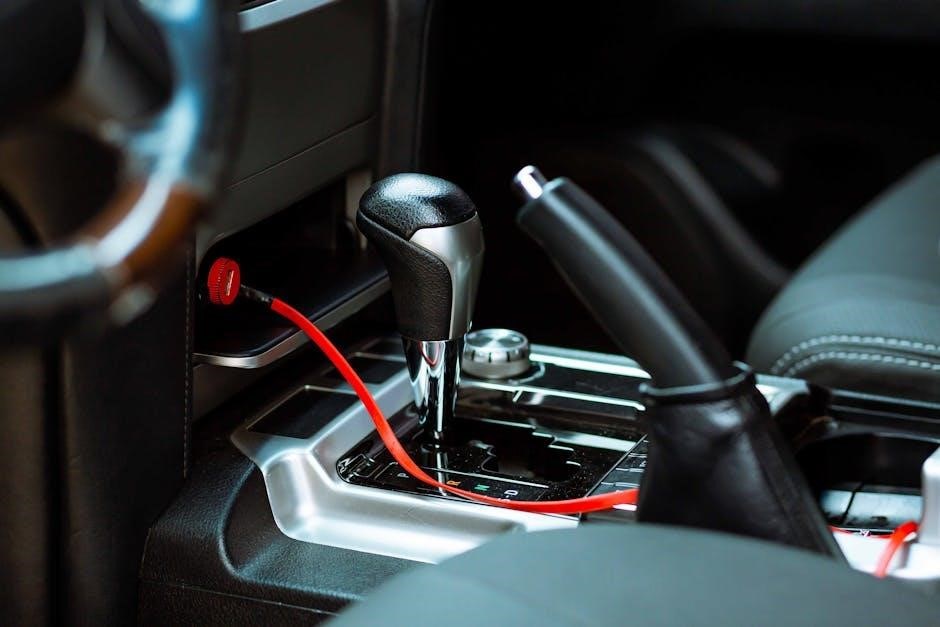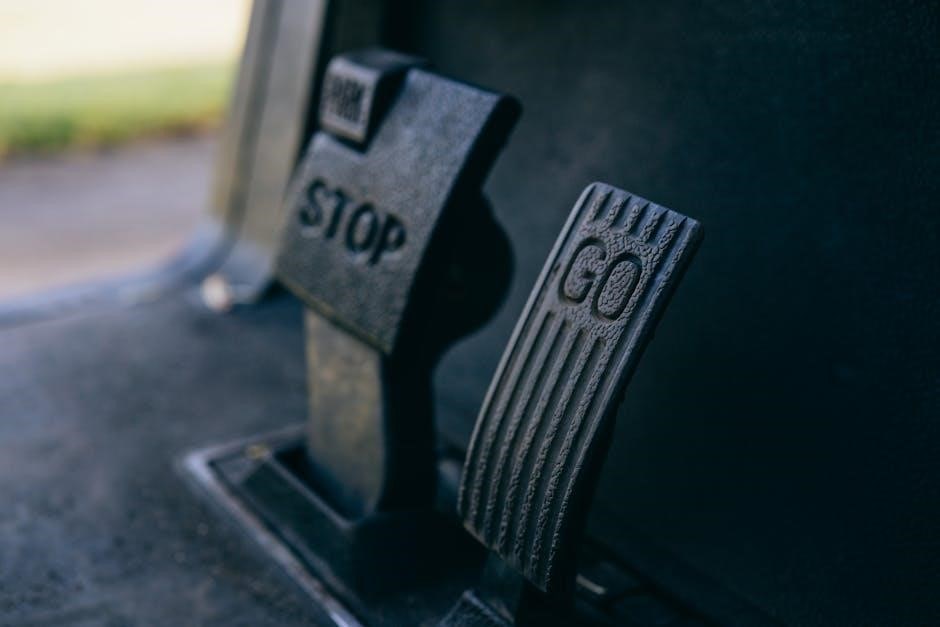Transmission coolers are essential for maintaining optimal temperatures in manual transmissions, preventing overheating and extending component lifespan. They efficiently dissipate heat from transmission fluid, ensuring smooth gear operation and performance reliability.

Overview of Transmission Coolers
Transmission coolers are specialized heat exchangers designed to regulate the temperature of transmission fluid in manual transmissions. They play a crucial role in preventing overheating, which can damage gears, seals, and other components. These coolers are typically air-cooled or liquid-cooled, with air-cooled models using external airflow and liquid-cooled systems integrating with the engine’s cooling circuit. Proper installation and sizing ensure efficient heat dissipation, maintaining optimal fluid viscosity and transmission performance. Overheating can lead to premature wear, making coolers essential for vehicles subjected to heavy loads or extreme driving conditions. Regular maintenance, such as fluid changes and line inspections, complements cooler functionality for long-term reliability.
Importance of Transmission Cooling in Manual Transmissions
Transmission cooling is vital for maintaining the health and longevity of manual transmissions. Overheating can cause irreversible damage to gears, seals, and bearings, leading to costly repairs. Transmission fluid serves as both a lubricant and a coolant, and its effectiveness diminishes when temperatures rise. Excessive heat can degrade fluid viscosity, reducing its ability to protect moving parts. Proper cooling ensures consistent fluid performance, prevents premature wear, and maintains smooth gear engagement. For vehicles subjected to heavy loads, towing, or extreme driving conditions, a reliable cooling system is essential to avoid overheating and ensure optimal transmission functionality. Regular monitoring and maintenance are critical for sustained performance.

Types of Transmission Coolers
Transmission coolers are categorized into air-cooled and liquid-cooled systems, each designed to efficiently manage heat transfer and protect transmission components from thermal damage.
Air-Cooled vs. Liquid-Cooled Transmission Coolers
Air-cooled transmission coolers use ambient air to dissipate heat from the fluid, making them lightweight and simple to install. They are ideal for vehicles with moderate cooling needs. Liquid-cooled systems, however, rely on the engine’s coolant to regulate temperature, offering superior cooling efficiency, especially in high-stress conditions. While air-cooled options are cost-effective and easy to maintain, liquid-cooled models provide consistent performance and are better suited for heavy-duty applications. Choosing between the two depends on the vehicle’s usage, as both designs ensure optimal transmission fluid temperature management. Proper installation and compatibility are key to maximizing their effectiveness. Always consider the vehicle’s specific requirements.
Stacked Plate Heat Exchangers for Transmission Cooling
Stacked plate heat exchangers are a popular choice for transmission cooling due to their high efficiency and compact design. These exchangers use a series of thin, stacked plates to maximize surface area, enabling effective heat transfer between transmission fluid and engine coolant. They are particularly beneficial for heavy-duty applications, as they handle high temperatures and flow rates with ease. The design ensures minimal pressure drop while maintaining durability. Stacked plate heat exchangers are often preferred for their ability to integrate seamlessly with existing cooling systems, making them a versatile option for both stock and aftermarket transmissions. Regular maintenance is crucial to prevent blockages and ensure optimal performance. Always choose a model compatible with your vehicle’s specifications for the best results.

Installation Guide for Transmission Coolers
Mount the cooler securely, connect transmission lines with barbed fittings, and ensure proper fluid flow. Always check for leaks and consult your vehicle’s manual for specific instructions.
Step-by-Step Installation Process
Begin by locating a suitable mounting spot for the cooler, ensuring good airflow. Next, disconnect the battery to prevent electrical interference. Attach the cooler using brackets or adhesive mounts; Then, connect the transmission lines to the cooler’s inlet and outlet ports using barbed fittings. Tighten all connections securely. Bleed the system to remove air bubbles. Finally, test the cooler by running the engine and checking for leaks or unusual noises. Always refer to your vehicle’s manual for specific instructions and ensure all materials are compatible with transmission fluid for optimal performance and longevity.
Materials and Tools Required for Installation
Key materials include a transmission cooler, barbed fittings, transmission fluid, and compatible hoses. Tools needed are wrenches, pliers, a drain pan, and a screwdriver. Additional items like clamps, mounting brackets, and seals ensure a secure setup. Properly chosen materials ensure compatibility with transmission fluid, preventing leaks or damage. Always refer to the vehicle’s manual for specific requirements. Gathering all components beforehand streamlines the installation process and minimizes downtime. Ensure tools are in good condition to avoid rounding bolts or damaging threads. Proper preparation is essential for a successful and leak-free installation.


Maintenance and Upkeep of Transmission Coolers

Regular inspection of transmission coolers ensures optimal performance and longevity. Check for leaks, damage, or debris buildup. Replace worn-out components promptly to maintain efficiency and prevent overheating issues.
When to Change Transmission Fluid
Changing transmission fluid is crucial for maintaining manual transmission health. Typically, fluid replacement is recommended every 30,000 to 60,000 miles, depending on vehicle usage and manufacturer guidelines. Signs of degraded fluid, such as dark color or a burning smell, indicate the need for a change. Proper fluid maintenance ensures smooth gear shifts and prevents overheating. Always refer to your vehicle’s manual for specific intervals and guidelines. Regular fluid changes are cost-effective preventive measures against transmission damage and extend the lifespan of your manual transmission system. Consistency in fluid maintenance is key to optimal performance and durability;
How to Monitor Transmission Cooler Performance
Monitoring transmission cooler performance is essential to ensure optimal functionality. Regularly inspect for leaks in the cooling lines and connections, as even minor leaks can lead to significant issues. Check the transmission fluid level and condition; discolored or burnt-smelling fluid indicates potential overheating. Use a thermometer to measure the cooler’s inlet and outlet temperatures, ensuring they remain within a safe range. Additionally, visually inspect the cooler for damage or blockages that could impede airflow or fluid flow. Addressing these factors promptly helps maintain efficient cooling, preventing damage to your manual transmission. Regular checks ensure longevity and reliability.

Troubleshooting Common Issues
Common issues with transmission coolers include leaks, overheating, and restricted fluid flow. Inspect lines for cracks, check for blockages, and monitor fluid condition to address problems early.
Identifying Leaks in Transmission Cooling Lines
Identifying leaks in transmission cooling lines is crucial to prevent fluid loss and damage. Start by visually inspecting the lines for cracks, corrosion, or damage. Use a pressure test kit to detect leaks under pressure, as cracks may not be visible. Check connections and fittings for looseness or signs of seepage. Transmission fluid on the ground or underside of the vehicle often indicates a leak. Regularly inspect the cooler lines, especially after installation or maintenance. Addressing leaks promptly prevents further damage and ensures optimal transmission performance. Always use compatible materials and proper sealing techniques to avoid future issues.

How to Prevent Overheating in Manual Transmissions
Preventing overheating in manual transmissions requires a combination of proper maintenance and driving practices. Regularly check and change transmission fluid to ensure optimal cooling properties. Inspect the coolant level and condition, as it plays a critical role in heat dissipation. Avoid aggressive driving or towing heavy loads, which can generate excessive heat. Install a high-quality transmission cooler, especially if you drive in extreme conditions. Monitor transmission temperature using a gauge and address any spikes promptly. Ensure proper airflow around the transmission and cooler by maintaining adequate clearance. Finally, avoid driving in extreme temperatures without proper precautions to safeguard your transmission’s health.
A transmission cooler is vital for maintaining your manual transmission’s health, preventing overheating, and ensuring longevity. Proper installation and maintenance are key to optimal performance and durability.
Final Thoughts on Transmission Cooler Importance
Transmission coolers play a pivotal role in safeguarding manual transmissions from heat-related damage. By effectively dissipating heat, they prevent fluid degradation and ensure smooth gear transitions. Proper installation and regular maintenance are crucial for optimal performance. Overheating can lead to costly repairs, making a high-quality cooler a wise investment. Additionally, using compatible transmission fluid and monitoring temperature levels further enhances system reliability. In summary, prioritizing transmission cooling is essential for maintaining the longevity and efficiency of your manual transmission, especially in demanding driving conditions. Regular checks and timely interventions can prevent major issues, ensuring your vehicle runs smoothly for years.
Best Practices for Longevity of Manual Transmissions
Ensuring the longevity of manual transmissions requires a combination of proper maintenance and smart upgrades. Regular transmission fluid changes are critical, as dirty fluid can lead to increased heat and wear. Installing a high-quality transmission cooler, such as a stacked plate heat exchanger, helps maintain optimal temperatures, especially in demanding conditions. Always use compatible transmission cooler hoses and barbed fittings to prevent leaks and pressure issues. Monitoring transmission temperature levels and addressing overheating promptly can prevent costly damage. Additionally, avoiding aggressive driving and ensuring proper fluid levels further contribute to the transmission’s lifespan. These practices collectively safeguard your manual transmission’s performance and durability over time.